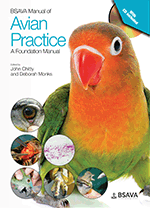
Full text loading...

In avian practice, loss of body condition is a common presentation. In general, birds with weight loss must always be treated as emergencies as such a condition may quickly lead to death. This chapter equips the reader with the necessary tools to diagnose the cause of and subsequently treat weight loss. Case examples: African Grey Parrot with chronic weight loss and acute seizures; Blue-fronted Amazon with liver fibrosis; Golden Parakeet with avian bornavirus.
The thin bird, Page 1 of 1
< Previous page | Next page > /docserver/preview/fulltext/10.22233/9781910443323/9781910443323.28-1.gif

Full text loading...




















